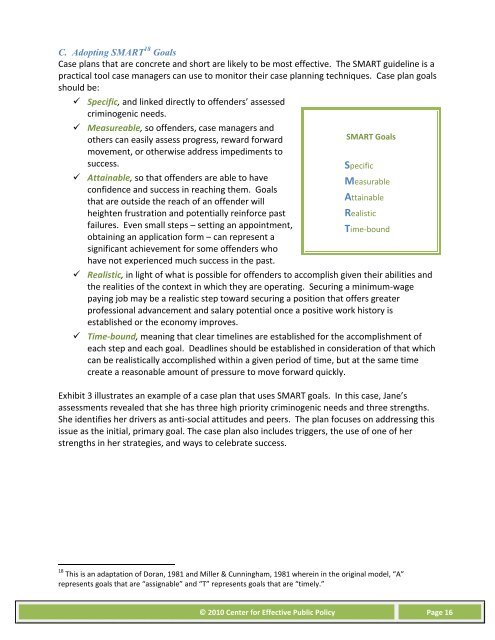COACHING PACKET Effective Case Management - The Center for ...
COACHING PACKET Effective Case Management - The Center for ...
COACHING PACKET Effective Case Management - The Center for ...
Create successful ePaper yourself
Turn your PDF publications into a flip-book with our unique Google optimized e-Paper software.
C. Adopting SMART 18 Goals<br />
<strong>Case</strong> plans that are concrete and short are likely to be most effective. <strong>The</strong> SMART guideline is a<br />
practical tool case managers can use to monitor their case planning techniques. <strong>Case</strong> plan goals<br />
should be:<br />
ü Specific, and linked directly to offenders’ assessed<br />
criminogenic needs.<br />
ü Measureable, so offenders, case managers and<br />
others can easily assess progress, reward <strong>for</strong>ward<br />
movement, or otherwise address impediments to<br />
success.<br />
ü Attainable, so that offenders are able to have<br />
confidence and success in reaching them. Goals<br />
that are outside the reach of an offender will<br />
heighten frustration and potentially rein<strong>for</strong>ce past<br />
failures. Even small steps – setting an appointment,<br />
obtaining an application <strong>for</strong>m – can represent a<br />
significant achievement <strong>for</strong> some offenders who<br />
have not experienced much success in the past.<br />
SMART Goals<br />
Specific<br />
Measurable<br />
Attainable<br />
Realistic<br />
Time-bound<br />
ü Realistic, in light of what is possible <strong>for</strong> offenders to accomplish given their abilities and<br />
the realities of the context in which they are operating. Securing a minimum-wage<br />
paying job may be a realistic step toward securing a position that offers greater<br />
professional advancement and salary potential once a positive work history is<br />
established or the economy improves.<br />
ü Time-bound, meaning that clear timelines are established <strong>for</strong> the accomplishment of<br />
each step and each goal. Deadlines should be established in consideration of that which<br />
can be realistically accomplished within a given period of time, but at the same time<br />
create a reasonable amount of pressure to move <strong>for</strong>ward quickly.<br />
Exhibit 3 illustrates an example of a case plan that uses SMART goals. In this case, Jane’s<br />
assessments revealed that she has three high priority criminogenic needs and three strengths.<br />
She identifies her drivers as anti-social attitudes and peers. <strong>The</strong> plan focuses on addressing this<br />
issue as the initial, primary goal. <strong>The</strong> case plan also includes triggers, the use of one of her<br />
strengths in her strategies, and ways to celebrate success.<br />
18 This is an adaptation of Doran, 1981 and Miller & Cunningham, 1981 wherein in the original model, “A”<br />
represents goals that are “assignable” and “T” represents goals that are “timely.”<br />
© 2010 <strong>Center</strong> <strong>for</strong> <strong>Effective</strong> Public Policy Page 16


